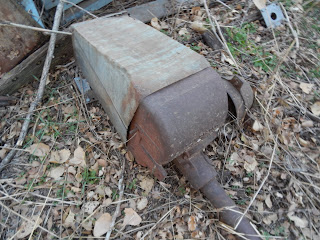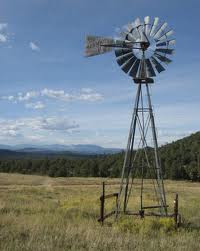Sunday, December 23, 2012
Wednesday, December 19, 2012
Tuesday, December 18, 2012
Sunday, December 16, 2012
Wind mill water pump home made P#1.
http://www.youtube.com/watch?v=FNt1OIbsc8Q&feature=youtube_gdata_player
Sent from my iPad
Saturday, December 15, 2012
Thursday, December 13, 2012
Submersible for stock watering
Wednesday, December 12, 2012
Dempster windmill
http://www.youtube.com/watch?v=a9yukqX4qR4&feature=youtube_gdata_player
Sent from my iPad
Pump rod relief between mill & well rod
Tuesday, December 11, 2012
Stock watering systems in Germany
Timers
Solar pumps pro & Cons
Safety ---everybody knows this!!
Monday, December 10, 2012
Shocking--Install new cylinder--no water!!
Maximize windmill life
1. Keep oiled, they all leak after a few month operation. ( heavy weight oil recommended)2. Keep tail pulled in about 1/2 way-- no need to run wide open. Wind may come up when you aren't around to shut it down.3. No pump reasonsA ). Leak in pipeB). Bad leathers, bad check valves , or plunger valve, or worn/ dirty cylinderC). Not in water far enough, at least ten feet recommended .D) broken pump rodE) broken trolley ( rod out), broken trolley drive mechanism.4. In cold areas, weep hole important plus rod relief if weep hole stopped up and rod freezes --- prevents damage to tower rod or head.5. Redundant check valve by installing cylinder( with good check valve ) with no plunger at end of active cylinder. Good for dirty wells.
Sent from my iPad
Sunday, December 9, 2012
Put two vice grips on pump rod before disconnecting from mill!!
Unusual well pulling Experiences!
Securing cable to well pipe
Wire size for pumps
Saturday, December 8, 2012
Weep holes
Additional information on 1/2 hp Submersible/ Independent of power companies.
1/2 hp pump--115 vac--no control box----$250
2400 watt, 24 vdc input, 120 vac output-----$600
2 12 volt deep discharge batteries -----$300
100 Watt solar panel--24vdc output---- $400 ( see buyers guide on this site)
Timer ---$100
Run pump 60 minutes for 400 gallon per day---ten minute segments --6 over day light hours to distribute load on battery. For less water per day, reduce run time accordingly. Pump output 7 gallon per minute.
For 200 gallon per day, run pump .5 hour. ( six 5 minute segments ) One hour run = 370 watt- hours discharge. 7 hours of solar output at 100 watts = 700 watt-hours input.
You have the flexibility of running for longer periods by utilizing a 1000 watt ac generator..
Friday, December 7, 2012
Windmill wheels/blades
Thursday, December 6, 2012
Put in new 2.5 inch brass cylinder--Pumped fast with minimum wind!
Wednesday, December 5, 2012
Shallow vs. Deep wells re: cylinder condition
Tuesday, December 4, 2012
Timken Roller Bearings re: Dempster vs. Aeromotor
Article regarding old windmill wells in Nebraska & EPA
Metal cased wells can be cased with plastic, gravel packed, with proper seal at top can meet the requirements delineated by state of Nebraska. Beware , this will eventually occur in all states since the abundance of state & federal bureaucrats continues to increase. Of course enforcement will lag due to vast area to be covered. The fact that EPA Nebraska has homed in on this indicates it will likely be picked up by other states in time!!
Dumpster pump jack
| Dempster Worm Gear Pump Jack Installation | DEAN BENNETT SUPPLY | ||||||||||||||||||||||||||||||||||||||||||||
The Dempster Pump Jack is designed to operate a hand pump or windmill pump, with an electric motor, gasoline engine or other power source. The kits described adapt the basic gearcase for the first two drives. In addition, it can be powered by any other source which is adaptable to provide up to the maximum of 40 strokes per minute ( 640 RPM shaft speed ). The basic pump body for which this jack is designed, has a 3-1/2" outside diameter barrel and a 7/16" x 1" flatbar, to which the crosshead is attached. The gearcase can be attached to slightly larger or slightly smaller barrels by carefully shimming and positioning. The pump jack may be used as a backup to a windmill to provide water on calm days, or if the windmill is out of service. However, since the relative strokes will not coincide, only one pinned connection must be used at a time. Ie: you can not run a windmill and pump jack at the same time. For instance, the mill wood pole must be removed from the flatbar when the pump jack is to operate. The hand pump handle must be disconnected when the jack is to be operated, just as the handle must be unpinned or the jack must be removed when the mill is operated. The handle must only be attached when pumping by hand (jack may stay in place on hand pump with the flatbar pin removed). For this reason, carefully study the operating methods to be used to determine the appropriate positioning of the gearcase and the set of pitman holes to be used to attach the crosshead. | |||||||||||||||||||||||||||||||||||||||||||||
|  | ||||||||||||||||||||||||||||||||||||||||||||
| Pump jack load limits for the BB33 pump jack are as follows. The BB33 Dempster should not be used with a greater than 1/2 hp electric motor, or a 1-1/2 hp gasoline engine. The speed must not exceed 40 strokes per minute (640 RPM shaft speed) under any circumstances. Warranty is void if the load limits or the recommended capacities are exceeded. GEARCASE TO PUMP BODY The length of the pump jack stroke is 6" and will generally not be the same as the windmill or hand pump stroke. For this reason, each power source must be attached separately. --Operate the pump jack, and locate the center of the stroke, and hold the pump rod in this position. The center of the flatbar pin hole at this distance above the fulcrum top, is the primary reference point used to determine positioning of the gear case. --Mark the hand pump body 41-1/4" or 44-1/4" below this reference point, as appropriate to attach the pitmans for clearance of cranks, and the pump handle, ect. --Secure the gear case to the hand pump body opposite the spout on the hand pump, using the U-bolt at this point. Tighten the nuts securely, but be careful not to crack the hand pump or the gear case bodies by over-tightening. --Always pin the hand pump handle to the flatbar to hold or position the pump rod when changing connections. In some case, when disconnected, the free rod may drop far enough that the hole will not be accessible to attach the handle. --Slide the cross head over the flatbar, however do not pin now. --Attach single hole end of the wood pitmans to the crank arms, securing them with flat 1" washers and 3/16" x 1-1/2" cotter pins. --Assemble cross bars to the cross head, and install bars in appropriate holes in pitman arms. Secure the assembly with a 3/8" x 1-1/2" bolt and hardware on each end. --Position flatbar in cross head and install pump pin. Secure with 1/8" x 1" cotter pin. Remove the hand pump handle. --FILL EACH SIDE of the main frame crank case, through the top plug to the Oil Level plug with 80-90 winter weight gear oil, which takes approximately 1/3 pint each end. --Be sure to replace the plugs after filling with gear oil. --Turn pump jack through several revolutions by rotating the drive pulley counter-clockwise, by hand, to be sure there is no interference mechanically or at either end of the stroke. Double check crank rotation as noted by arrow on the gear case. DO NOT OPERATE WITHOUT LUBRICATION IN CRANK CASE. | |||||||||||||||||||||||||||||||||||||||||||||
PERFORMANCE
| Electric Motor Drive is to be 1750 RPM with a 5/8" shaft 1/2 HP maximum. -Attach the motor bracket to the cover plate with 3 3/8" x 3/4" cap screws included in the cover bosses. The motor bracket should be installed flat side up. -Attach the motor rails, with the flat side down and the ears for the bolts facing toward the gear case. Use 2 bolts 5/16" x 1-1/4" cap screws and nuts each. The three components are slotted to adapt to the motor and for motor adjustment purposes. -Install the motor on the motor bracket on the motor rails loosely, opposite the flat sides. IE on top. Insert 5/16" x 1-1/4" cap screws from below, head must fit into slots. -Attach the 8" V-pulley to the pump jack shaft with 1/4" square x 2-1/4" key and tighten set screws in the pulley hub securely. -Attach the smaller 2-1/2" V-pulley to the motor shaft with 1/4" key and set screws. -Install V-belt. Slide motor on rails to align pulleys and then slide the rails on the motor bracket to adjust belt tension. Proper tension is 1/2" to 3/4" detention midway between the pulleys. Tighten all rail and motor mounting hardware. -Motor shaft MUST rotate counter-clockwise as viewed from end of shaft. IE: facing the motor end looking at the pulley and then the motor. -Be sure the crank case is lubricated before operating the pump jack. | ||||||||||||||||||||||||||||||||||||||||||||
|
| ||||||||||||||||||||||||||||||||||||||||||||
Package Components by item number.
| |||||||||||||||||||||||||||||||||||||||||||||
| GASOLINE ENGINE 1-1/2 hp MAXIMUM or Electric Motor 1/2 HP Maximum. The Electric Drive Components Package #380-1-6005 comes with an 8" V-pulley for the pump jack shaft, in addition to the cross bar items. The #380-1-6006 Gas Engine Drive Components Package comes with a 8" single groove V-pulley for the pump jack shaft, along with the cross bar items. -Attach the gear case and the pitman arms to cross bar assembly as described for the electric motor.
Dempster pump jack operation. When using a windmill and pump jack combination, ALWAYS completely detach the windmill wood pole or the pump jack cross head, before attaching the other operating source. The operating strokes will very rarely coincide enough to allow you to operate with both drive sources, without possible interference between them. | |||||||||||||||||||||||||||||||||||||||||||||
Sent from my iPad
Sunday, December 2, 2012
Brakes & tail vane operation
Oiling windmills----A Better Approach!
I have a new design which still requires climbing, to connect/disconnect a quick disconnect---a one handed operation.
With this design the head cover is modified with a short piece of 3/8 copper tube inserted with a seal to prevent water intrusion with a easy to mate connector. After connection simply pump oil into head from ground via a plastic tube & climb up to disconnect when done. Elimination of cover removal & carrying oil up is a big improvement.
Working on design for oiling from ground.
Pump rods ( sucker rod)
Saturday, December 1, 2012
6 or 8 foot Aeromotor Head Repair
1. Remove pitman arms.
2. Remove two big gears
3. Remove main shaft/ hub assembly.
4. Install main shaft long bearing after removing old one.
5. Install new babbit bearing between two new small gears on main shaft.
6. Key main shaft with cotter key.
7. Install rebuilt /new big gears & bearing, tighten hold down strap.
8. Install new/rebuilt pitman arms.
9. Install new trolley shaft if needed & make sure oil ring in place.
When reinstalling head, if stub pipe is old , seriously consider new stub pipe. Make sure all bolts tight on stub tower.
Fill with 1 quart for six foot aerometer, 2 quarts for 8 foot aerometer.
In operation check every three months.















































